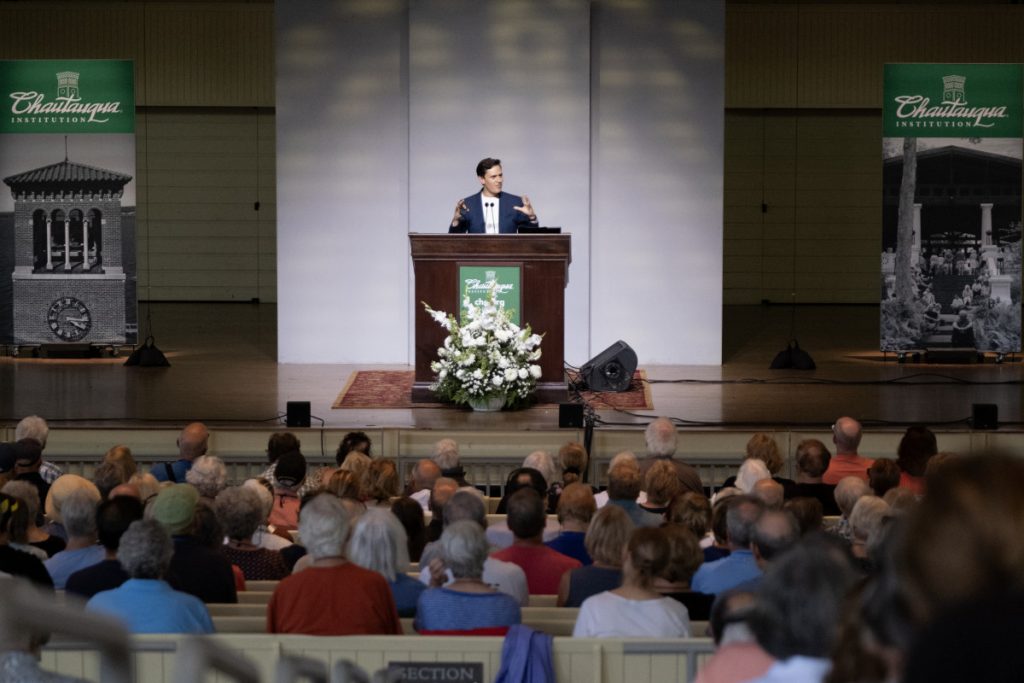
Alton Northup
Staff writer
Before 2016, Conor Knighton spent most of his time in “the great indoors.”
His fiancé had just called off their engagement, work had slowed down and he found himself in an apartment he could no longer afford in a city with memories he wanted to leave behind. Stirred by the approaching National Park Service centennial, Knighton made an absurd pitch to “CBS Sunday Morning” to send him on a year-long trip across the country to document every national park.
“I wasn’t just chasing scenery,” he said. “I was chasing stories.”
Knighton documented a third of his journey in the “CBS Sunday Morning” report “On the Trail” and the entirety of it in his New York Times bestselling book, Leave Only Footprints: My Acadia-to-Zion Journey Through Every National Park. He presented a lecture of the same name at 10:45 a.m. Monday in the Amphitheater to discuss what he learned from his experience and to open the Chautauqua Lecture Series Week Seven theme, “The National Parks: How America’s ‘Best Idea’ is Meeting 21st-Century Challenges.”
Knighton traveled to his first national park, the Grand Canyon, when he was 14 years old. A resident of Charlestron, West Virginia, he said he felt as if he had landed in an alien world, not Arizona.
As he stared down at the layers of rock cut away by the Colorado River, revealing the canyon’s diary, he had a revelation.
“Our lives might be like the life of a canyon,” he said. “There are certain moments where there’s a line that’s drawn that says, ‘After this, everything’s different.’ ”
His trip to every national park was one of those lines.
There is no real way to visit every national park, Knighton said. Typically, it is a feat achieved after a lifetime, but his goal of completing it in a year meant he needed an itinerary.
“I was interested in the threads that tie these places together and that tie us to nature,” he said. “The parks are really all about connections.”
He decided to start his journey in Acadia National Park. Located in Maine, Acadia is home to Cadillac Mountain – the tallest mountain on the Atlantic Coast of the United States.
He visited the park on Jan. 1, during a time of year when it welcomes 50 times fewer visitors than in its summer season. However, he chose this date because the first sun rays of the new year would shine down on Cadillac Mountain.
That touch of sun launched him on his journey exploring the underground of Mammoth Cave in Kentucky, and underwater at Biscayne in Florida; he visited the lowest point in the country at Badwater Basin in Death Valley, and the highest point at Denali in Alaska. Each park gave him a new perspective on humanity’s relationship with nature, he said.
If the Grand Canyon offers a glimpse of earth’s past, then Hawai’i Volcanoes National Park offers a glimpse into its future. The park allows visitors to get “dangerously close” to oozing lava, which hardens and forms new rock.
“It’s like mother nature was giving birth, and you get to hang out in the delivery room,” Knighton said.
On the trip, he had the chance to talk to locals who lived along the path of the lava flow. Their homes stood where lava once did — and where it would return — so he asked if they were concerned.
“They all mentioned that that helped them appreciate their day-to-day life, that none of this is permanent,” he said. “To have a visual reminder of that right out of your front door — to them, that made them savor every day more.”
A volcano also gave way – literally, as it is a collapsed volcano – to Crater Lake National Park in Oregon. Home to mysterious features such as Wizard Island – named by William Steel as part of his 17-year campaign to designate Crater Lake as a national park – the most mysterious entity may be the Old Man.

Carbon-dated to at least 450 years old, the Old Man is a 30-foot mountain hemlock log that researchers first spotted floating on the surface of the country’s deepest lake in 1896. For more than a century, the Old Man has mystified visitors with lore of its supernatural ability to control the weather and the origin of its vertical bobbing.
Knighton spoke with an aquatic ecologist there who admitted he not only understood little about the Old Man, but was OK with it staying a mystery.
“In a world in which everything feels like it’s a Google search away in your pocket, to be able to have some things that are unexplained helps ignite the curiosity of further generations,” Knighton said.
Mesa Verde National Park in Colorado also mystifies its visitors with cliff dwellings of the Ancestral Puebloans. Questions of why the Puebloans moved to the site of the cliffs, and why they abandoned them just 100 years later, remain unanswered. It was the first park designated for archaeological protection of works created by people, and serves as a reminder that all national parks were once someone’s home, Knighton said.
Everglades National Park in Florida, home to 36 endangered or threatened species, is another first. Authorized in 1934, it was dedicated by President Harry Truman in 1947 and established as a refuge for the species that lived there.
“Here is land, tranquil in its quiet beauty, serving not as the source of water, but as the last receiver of it,” Truman said, according to the National Park Service. “To its natural abundance we owe the spectacular plant and animal life that distinguishes this place from all others in our country.”
National parks have become a lab for saving species, Knighton said. Channel Islands National Park saw the fastest delisting of an animal, the island fox, from the endangered species list.
Death Valley National Park claims the only population of the Devils Hole pupfish, found only in Devils Hole, a water-filled cavern in the park. Devils Hole is fenced off from the rest of the park, and each year divers enter the unmapped cavern to count the critically endangered species. Knighton visited the park on fish-counting day, and learned the population had increased from 60 fish to 120 fish.
“As destructive as a species as we can be, we’re also the only species that really goes out of our way to protect other species for no tangible benefit to ourselves,” he said.
At Everglades, Truman noted the conservation there was also the conservation of the human spirit. This continues in park after park.
Indeed, national parks are also refuges for people. Isle Royale National Park in Michigan is the seventh least-visited national park in the country but also records the longest stays. Located far past the Upper Peninsula, it is the fourth-largest lake island in the world and notoriously difficult to travel to. Knighton recalled feeling “blissfully disconnected” at the park, where he had no cellphone service.
Kobuk Valley National Park in Alaska is also one of the least-visited parks in the country. Slightly larger than the state of Delaware, the park has no roads or trails. However, Kobuk Valley is highly valuable to the local communities for hunting.
Because the park lies so far north, Knighton never saw the sunset there. But in parks such as Great Basin, half of the experience happens after dark. The park’s “Dark Rangers” give nighttime tours of the Great Basin as it fills with clear views of stars, and educate visitors on how they can make their community more dark-sky friendly.
Light pollution is an entirely reversible form of pollution, Knighton said. The effects of climate change, he said, take more than the flick of a light switch to solve.
At Kenai Fjords National Park in Alaska, signs line the trail as visual markers of where glaciers once stood — even as recently as 2005. The Grinnell Glacier in Montana’s Glacier National Park has retracted substantially, from 710 acres in 1850, to 220 acres by 1993.
“There’s no park that is immune from (climate change’s) effects,” he said.
As Knighton wrapped up “the longest year you could possibly have,” he spent his New Year’s Eve watching the sunset from the edge of Point Reyes National Seashore in California. However, he was not ready for his journey to end. Since he started in 2016, four more national parks have been established, including New River Gorge National Park and Preserve in his home state of West Virginia.
“There are treasures in all of our backyards,” he said.




